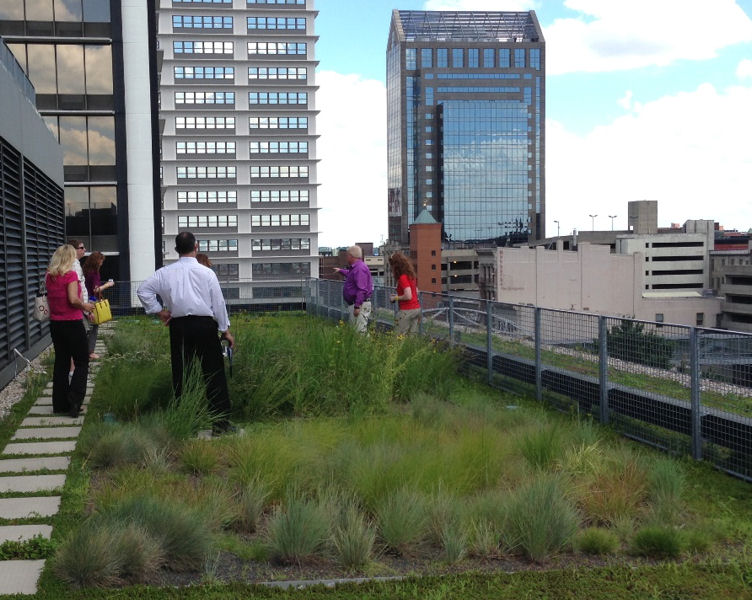
Louisville/Jefferson County Metropolitan Sewer District (MSD; Ky.) works to educate both the public and water-sector professionals about its green infrastructure. Activities included conducting a workshop and tour of green infrastructure as part of the Kentucky–Tennessee Water Environment Association annual conference. Photo courtesy of Water Environment Federation (Alexandria, Va.) member Tim Moran.
Obtaining community support to fund wastewater treatment remains an elusive goal for many water resource recovery facilities (WRRFs). When new projects are needed and resulting costs must be passed on to the community, the concept of public buy-in haunts facility managers.
Working with the community
The Louisville/Jefferson County Metropolitan Sewer District (Ky.) was no different. In 2005, the district came under a consent decree and began developing a plan to address sewer overflows. But when the decree committed the district to forming a stakeholder group to help formulate the plan, the district learned many lessons from community leaders. The foremost lesson was to be proactive with communications and start talking about projects during the planning stage.
So, the district began spreading the message of the value of wastewater treatment services and ways the public could contribute to reducing overflows, explained Wesley Sydnor, senior technical services engineer at the district. The district has attempted to relay these messages through such various formats as print and online advertisements and quarterly community meetings.
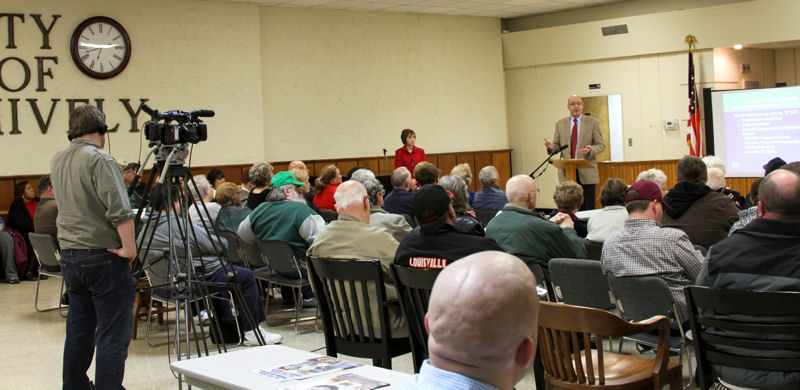
MSD hosts quarterly community meetings to gather input and answer questions about upcoming projects. Photo courtesy of MSD.
“It’s an opportunity to get that message across and get people to buy-in that we’re all in this together,” Sydnor said. Starting in 2006, the 30-member stakeholder group met monthly for 18 months and continues to meet on a semiannual basis. Quarterly community meetings, which are broadcast on a local government cable channel, started in 2011 and have been drawing between 50 and 100 attendees. Meeting attendees can ask questions or submit comments either during or after the meeting.
“We spend several weeks after the meeting compiling the questions and comments and formally responding,” Sydnor said. “It’s a lot of time but we feel like it’s worth it.” Public involvement through this format has led the district to pursue studies, conduct further research, and even change or initiate projects, Sydnor said.
The district also conducts a survey every couple of years to determine if people are learning more about the value of water and issues in the water sector. Results have not yet verified that the public is learning from the messages, but the district is committed to continuing to pursue educational outreach.
“We’re hoping that by continuing to get out there and meet with people and have some of those face-to-face discussions that we can start to get some momentum as far as getting … a broader group of people’s buy-in for these projects and what we’re trying to do,” Sydnor said.
Using green infrastructure to complement the gray
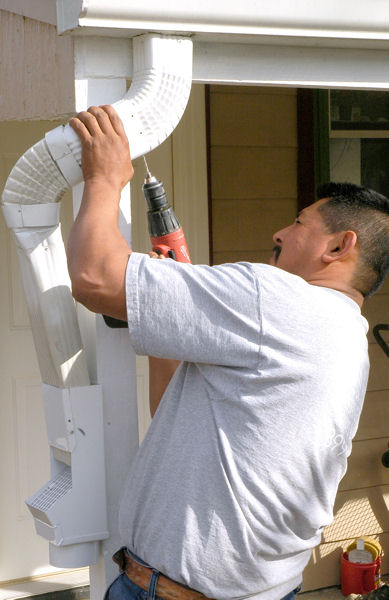
MSD offers information and incentives for downspout disconnection in an effort to reduce stormwater runoff. Photo courtesy of MSD.
While the district primarily is installing gray infrastructure to handle stormwater, it also has a green infrastructure component that involves community education and incentives.
“We have a pretty extensive green infrastructure incentive for properties within the combined sewer system,” Sydnor said. “We really encourage, first of all, disconnecting downspouts and taking that runoff from homes and directing it to a rain garden.” This prevents water from making its way into the district’s combined sewer system and results in cost savings, Sydnor explained.
Since August 2011, the district has been offering companies stipends and credits on stormwater fees for directing runoff toward such green infrastructure elements as rain gardens, bioswales, infiltration galleries, and pervious pavement. The district has recouped its $15 million investment and earned approximately an additional $2 million for this program.
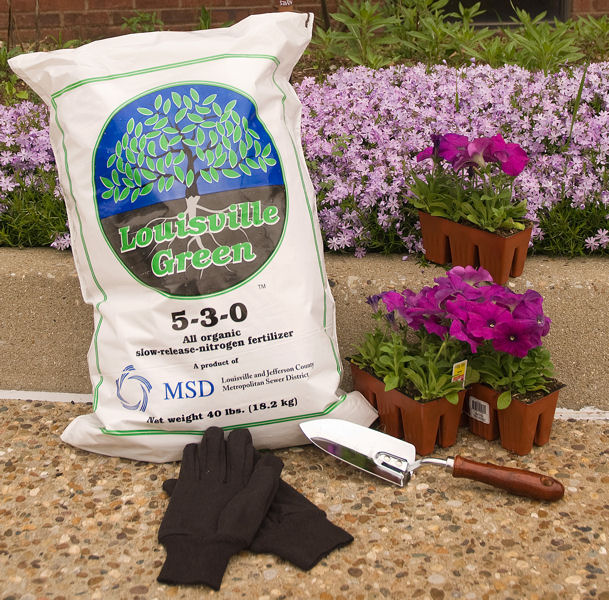
Louisville Green is a fertilizer produced from MSD's biosolids and sold to large farms. Photo courtesy of MSD.
The district also dries its biosolids to generate a fertilizer called Louisville Green. Since 2004, the district has sold to large farms the nearly 70 tons per day that it generates. “We can’t make enough to keep up with demand,” Sydnor said. The program began so the district could avoid the fees associated with disposing of biosolids in landfills, and now the district uses methane generated by the system digesters to run its driers, said Robert Bates, wastewater operations manager.
Other green efforts include conducting stream restorations to assist in controlling stormwater, providing information on where to buy rain barrels, and conducting educational events such as a workshop at the Kentucky–Tennessee Water Environment Association annual conference.
The workshop educated attendees about a program the district is working on with the U.S. Environmental Protection Agency (EPA) to collect and publish data on the maintenance needed for optimal level of green infrastructure performance. “We are working with EPA’s Office of Research and Development to determine what is the value and how do different types of practices perform,” Sydnor said.
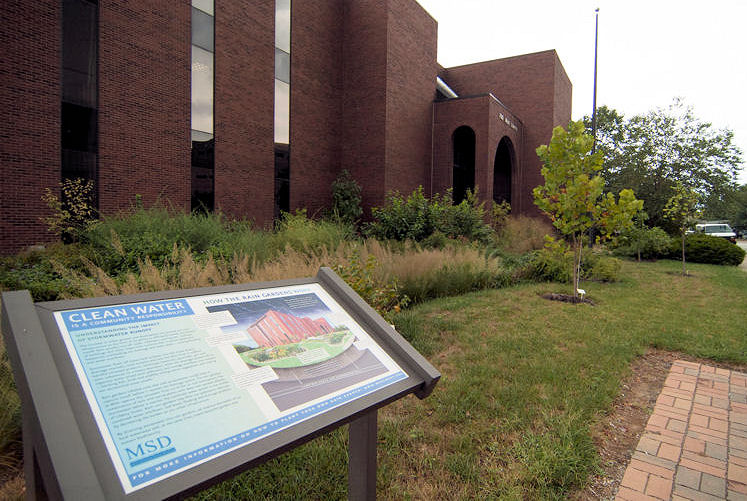
MSD installed a rain garden on its property that it monitors to determine the maintenance needed for optimal performance of green infrastructure. Photo courtesy of MSD.
“I was most interested in how they were experimenting with maintenance of various green infrastructure sites,” said Water Environment Federation (Alexandria, Va.) member Tim Moran, who attended the workshop. He learned about how the district researches the effect that conducting maintenance four times, three times, and two times a year has on rain garden performance. The research determined that semiannual maintenance is not enough, Moran said.
Ongoing data collection ensures efficiency
Currently, the district is considering launching a rebranding campaign, providing upfront incentives for residents to disconnect downspouts, finding ways to increase personal interactions, and using social media to spread its messages, Sydnor said. The district’s website provides much information and drew more than 30,000 unique visitors last year.
Although the district has experienced success and interest in many of its initiatives, some are expensive. So, it is conducting research to find the best areas for investment and determine “where do we get the most value and where can we focus our dollars and our efforts,” Sydnor said. It also is in the process of creating an overflow plan in the consent decree to build a business case for the value of doing different types of green practices, he added.
— Jennifer Fulcher, WEF Highlights








October 3, 2013
Featured